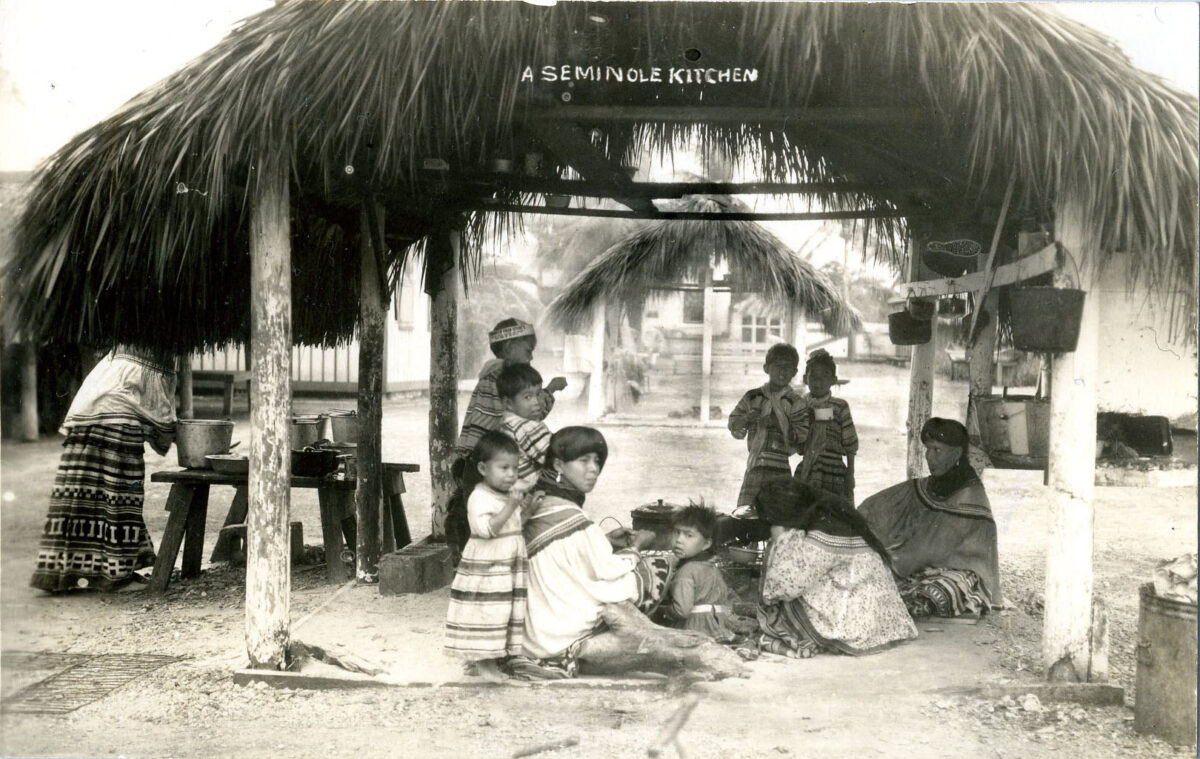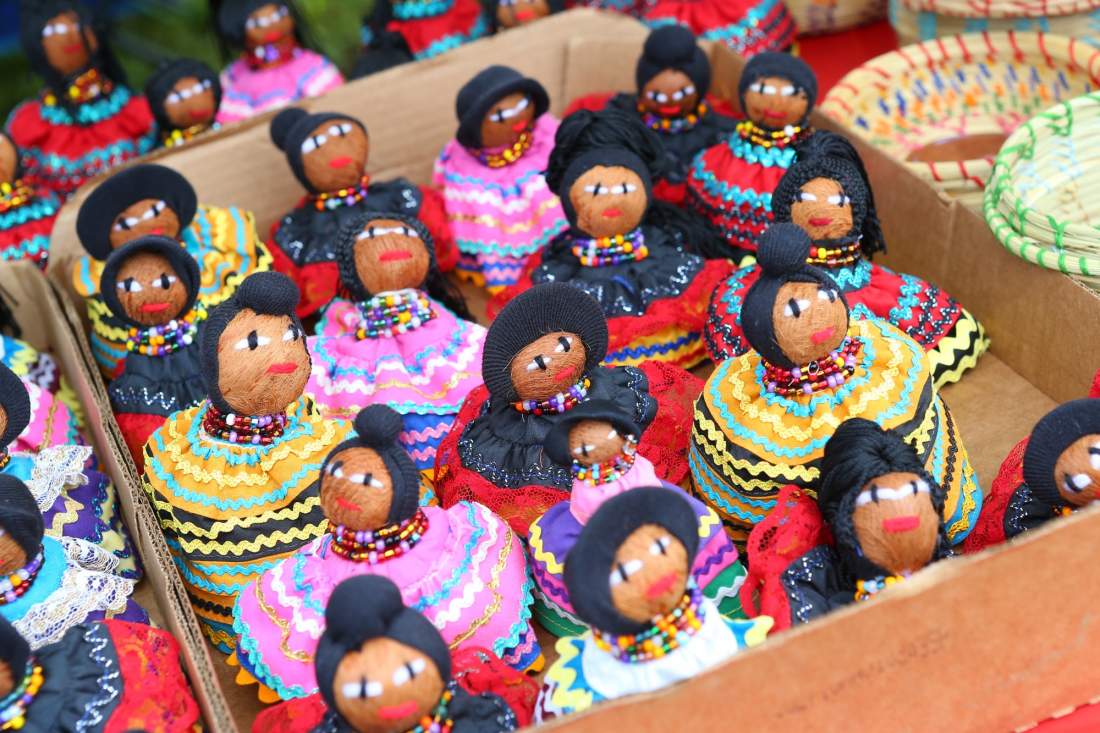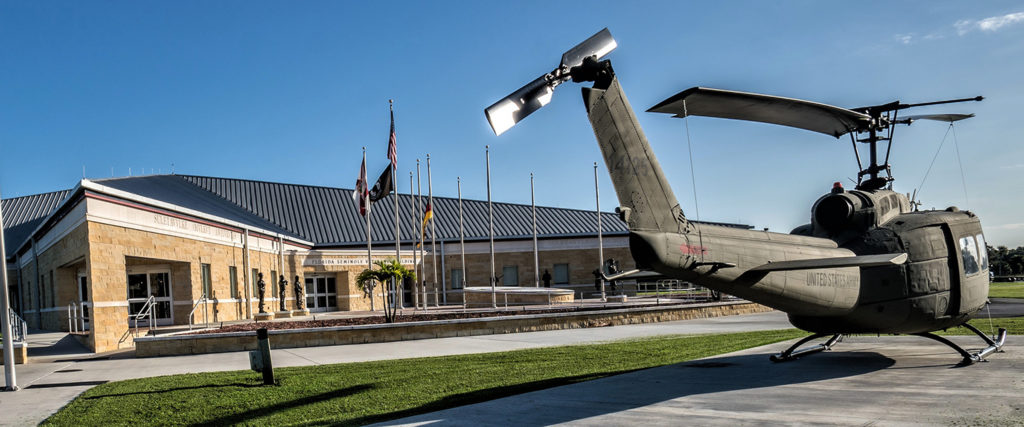
Native American Heritage Month
November is Native American Heritage Month! Declared for the first time on August 3, 1990 by President George H.W. Bush, it seeks to uplift and honor native voices, art, music, and culture. But, how can you participate thoughtfully? This week, follow along to learn eight things you can do to celebrate Native American Heritage Month. In our featured image for this week, you can see a Seminole family preparing a meal in a cooking chickee (2001.27.3, ATTK Museum).
For the purposes of this post, we are being broad in our language surrounding native cultures and tribes to provide a list of action items the average reader can achieve. But, remember and respect that each tribe is a sovereign entity. There are 574 federally recognized tribes in the United States, with many more state or not recognized. Like other cultures, these tribes are not a monolith. Thus, they are not all the same, and part of Native American Heritage Month is celebrating each unique culture and their traditions. When celebrating this month, do your best to engage with tribes respectfully and honor their sovereignty.
What is Native American Heritage Month?
Native American Heritage Month was designated for the first time in November 1990. Federally, it has been recognized in some way (sometimes under different titles, but functionally the same) each year since 1994. The intention of Native American Heritage Month is two-fold: to celebrate and educate. Firstly, it seeks to celebrate the rich cultural diversity of the original inhabitants of the United States by providing a platform to highlight traditional native dance, music, art, culture, and more. Secondly, it provides an opportunity to educate people. The National Congress of American Indians states that Native American Heritage Month is the “opportune time to educate the general public about tribes, to raise a general awareness about the unique challenges Native people have faced both historically and in the present, and the ways in which tribal citizens have worked to conquer these challenges.” Consequently, many institutions do this through a series of programs and events throughout November.
But, how do you do this in an authentic, thoughtful way? In an 2019 op-ed Ruth Hopkins (Dakota/Lakota Sioux) lamented “widespread ignorance on all things Native means that November is often replete with shocking instances of anti-Native prejudice, cultural appropriation, and the enforcing of hostile, negative, racist, misogynistic stereotypes about Native people.” Hopkins’ op-ed “Celebrating Native American Heritage Month: Dos and Don’ts” gives the reader tips to celebrate appropriately, including rejecting cultural appropriation and amplifying native voices. Many of those tips include the reader reflecting on their own actions and choices, and how they may enforce negative stereotypes. We encourage you to always be critically self-reflective, as Hopkins suggests. In addition, below are eight things you can do to celebrate Native American Heritage Month this November.
Eight Things YOU Can Do
1. Support Authentic Native Art and Artists
Supporting native artists, art, and businesses is a great way to celebrate Native American Heritage Month! Find ways to celebrate native makers. Amplify art and artists you like, and support their businesses. In an earlier blog post, we discussed how difficult it is to stop counterfeit native arts and crafts. It is illegal to sell or falsely advertise native art under the Indian Arts and Crafts Act of 1990. Violators face up to $500,000 in fines or 5 years in prison. If a business knowingly violates the Act, they could be penalized up to $1,000,000. But, even with this law in place, counterfeits are a significant issue in the native art market. So, do your best to be an ethical consumer of native art, and verify it is authentic. In addition, avoid purchasing culturally appropriative goods from major retailers. Culturally appropriative goods and inauthentic art hurt native art and artists.
2. Visit a Tribal Museum or Heritage Center
Do you know if there is a tribal museum or heritage center around you? Have you looked? Visiting a tribally-affiliated museum is a great way to learn about native history, culture, and art. In particular, it allows you to learn from the native perspective, and from their own voices. For most of history, those voices have been suppressed and marginalized. You can work to correct that history by learning and engaging with native history in a way that centers a native perspective and culture.
If you are in South Florida, the Ah-Tah-Thi-Ki Museum on the Big Cypress Seminole Indian Reservation is a perfect option. With the mission to “celebrate, preserve, and interpret Seminole culture and history,” visiting the Museum is a wonderful, authentic educational opportunity you don’t want to miss!
3. Be an Ally Year-Round
Don’t confine yourself to Native American Heritage Month! Although it provides a great platform for highlighting native culture and perspectives, work to be an ally year-round. But, what does it mean to be an ally? Being an ally means acknowledging the power imbalance that exists to marginalize indigenous communities, while working to challenge and break down that power imbalance. Try to take small, actionable steps in your own life to combat this imbalance.
Be responsible for your own actions, words, and past mistakes. Prioritize educating yourself, examining your actions, and listening to the needs of the community. Center native voices, perspectives, and issues. Being an ally benefits everyone. While this sounds difficult (and it is!) there are many things you can do to be an ally, including many of the things on this list.
4. Do Your Research
Learn about the original inhabitants of where you live, work and travel. Especially in November, seek to honor and understand the first inhabitants of the land you stand on. Educate yourself and seek out the correct historic and cultural context. What issues are facing native people in your area now? Support conservation efforts that center native perspectives and issues. Traveling anytime soon? Do your research beforehand, and work to be an ethical eco-tourist. If you’re a parent, teach your children about native history, and read books with native representation by native artists.
5. Attend an Event
One of the biggest benefits of Native American Heritage Month is that it provides an opportunity to educate and inform a large population through programs and events. A great way to participate is to seek out some of these events and programs, either in person or digitally. So, find teacher-designed programs for your children and family to attend, and exhibits to explore. A list of featured collections and exhibits hosted by the Library of Congress can be found here.
Seek out appropriate events hosted by tribes for you to attend, such as the American Indian Arts Celebration (AIAC), hosted by the Ah-Tah-Thi-Ki Museum. If you are in South Florida and looking for an event to celebrate the beginning of Native American Heritage Month, AIAC starts TODAY November 4, 2022 and runs through November 5, 2022. But, if you can’t attend AIAC this year, mark your calendar for next November for this annual event.
6. Put Your Money Where Your Mouth Is
There are many ways to be an ally both during Native American Heritage Month and beyond. But, one that can have a lot of impact is being intentional with your finances. Is your money going to causes, issues, and organizations that center a native perspective? We encourage you to examine where your money is going, and put it towards entities that encourage, uplift, and center native issues.
7. Boost Native Voices and Issues
All year round, but especially during Native American Heritage Month, try your best to amplify native voices and issues. Utilize your power to bring awareness to issues that impact native people and places, and do your best to support their causes. Read native news sources, and educate yourself on issues that impact native people, rights, and land. Instead of speaking over native voices, step back and boost them up.
8. Reject Cultural Appropriation
Much like avoiding inauthentic art, cultural appropriation hurts native cultures and people. Like we mentioned above, cultural appropriation often reduces native people to stereotypes and doesn’t acknowledge their individual tribal sovereignty. It may even take away resources and support from those who need it. So, do the work to reject cultural appropriation, and call out those who (knowingly or unknowingly) uphold these stereotypes. For more information about cultural appropriation, and how to avoid it, check out a previous blog post here.
We hope this list helps you find the best ways for you and your family to celebrate and engage with Native American Heritage Month this year. As always, be respectful and remember that these cultures still exist! It is only through real-time acknowledgement and self-reflection that we can all do better. Native American Heritage Month is important, in part because it brings these issues and perspectives to the forefront. By acknowledging and educating ourselves, we can work towards a more inclusive, supportive, and respectful world.
Additional Resources:
American Indians in Children’s Literature
Native American Heritage Month
Author Bio
Originally from Washington state, Deanna Butler received her BA in Archaeological Sciences from the University of Washington in 2014. Deanna moved to South Florida in 2016. Soon, she began working for the Seminole Tribe of Florida’s Tribal Historic Preservation Office. Deanna was the THPO’s Archaeological Collections Assistant from 2017-2021. While at the THPO, Deanna worked to preserve, support, and process the Tribe’s archaeological collection. She often wrote the popular Artifact of the Month series, and worked on many community and educational outreach programs. She lives in Fort Myers, FL with her husband, son, and dog.



